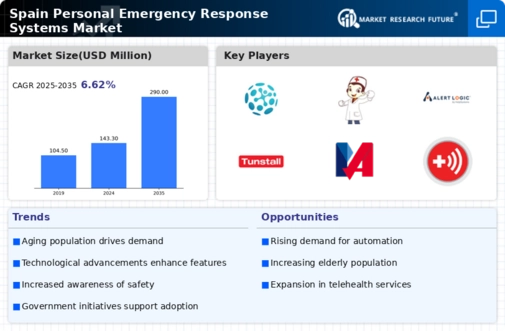Growing Urbanization
The trend of urbanization in Spain contributes to the expansion of the personal emergency-response-systems market. As more individuals move to urban areas, the need for efficient emergency response solutions becomes increasingly critical. Urban environments often present unique challenges, such as higher population density and increased risk of accidents. Consequently, residents are more inclined to invest in personal emergency-response systems that can provide immediate assistance in case of emergencies. Data suggests that urban areas in Spain have seen a population increase of approximately 5% over the past five years, which correlates with a rising demand for safety solutions. This urban growth is likely to drive innovation and competition within the personal emergency-response-systems market, as companies strive to meet the needs of a more diverse and densely populated consumer base.
Rising Health Awareness
The increasing awareness of health and safety among the Spanish population is driving the personal emergency-response-systems market. As individuals become more conscious of their health, the demand for systems that provide immediate assistance in emergencies is likely to rise. This trend is particularly evident among older adults, who are more susceptible to health issues. According to recent data, approximately 20% of the Spanish population is over 65 years old, a demographic that often seeks reassurance through emergency-response systems. The personal emergency-response-systems market is expected to benefit from this heightened awareness, as families prioritize the safety of their loved ones. Furthermore, educational campaigns about the importance of quick response in emergencies may further stimulate market growth, indicating a shift towards proactive health management.
Rising Insurance Coverage
The expansion of insurance coverage for personal emergency-response systems is emerging as a significant driver in the market. In Spain, insurance companies are increasingly recognizing the value of these systems in reducing emergency response times and improving health outcomes. As a result, many insurers are offering policies that cover the costs associated with purchasing and maintaining personal emergency-response systems. This trend is likely to encourage more consumers to invest in such systems, as they can now do so with financial support from their insurance providers. Recent statistics indicate that approximately 30% of new insurance policies in Spain now include provisions for emergency-response systems, reflecting a growing acknowledgment of their importance. This shift not only enhances market accessibility but also promotes a culture of safety and preparedness among the population.
Technological Integration
The integration of advanced technologies into personal emergency-response-systems drives market growth in Spain. Innovations such as GPS tracking, mobile applications, and wearable devices enhance the functionality of these systems, making them more appealing to consumers. For instance, the incorporation of real-time location tracking allows emergency responders to reach individuals faster, potentially saving lives. The personal emergency-response-systems market is witnessing a surge in demand for devices that can seamlessly connect with smartphones and other smart home technologies. This trend is likely to continue as technology evolves, with an estimated growth rate of 15% in the adoption of smart emergency-response devices over the next five years. As consumers seek more reliable and efficient solutions, the market is poised for significant expansion.
Increased Government Initiatives
Government initiatives aimed at improving public safety and health services are significantly influencing the personal emergency-response-systems market. In Spain, various programs are being implemented to promote the use of emergency-response systems, particularly among vulnerable populations. These initiatives often include subsidies or financial assistance for low-income families, making these systems more accessible. Recent reports indicate that government funding for health and safety programs has increased by 10% in the last year, reflecting a commitment to enhancing emergency response capabilities. This support not only encourages the adoption of personal emergency-response systems but also fosters partnerships between public and private sectors, further driving market growth. As these initiatives continue to evolve, they are likely to create a more favorable environment for the personal emergency-response-systems market.

















Leave a Comment